The deaths due to COVID-19 crossed the 9000 mark recently. There are apprehensions about this reported number by the government. But, what does the data about recorded deaths in India tell us?
As of 14 June 2020, the total deaths due to COVID-19 in India, as per government sources is 9,195. With a fatality rate of around 2.87%, India is among the countries with a low fatality rate, especially among those worst affected by the pandemic.
India has recently crossed more than 50% recovery rate as well. Therefore, in-spite of the increasing number of new cases, it can be concluded that the COVID-19 is not found to be as fatal as it has been observed in few other countries.
Few experts opine that nearly 70% of the COVID-19 deaths are due to co-morbidities. Few other think that there is an undercounting of the deaths caused due to COVID-19.
Is there a spike in the number of deaths occurring in India due to COVID-19? Or is it relatively similar to regular deaths due co-morbidities every year? The answers are uncertain, especially due to lack of data. In this story, we explore the data around recorded information of deaths in the country and the causes & trends around these deaths.
Lack of comprehensive mortality related data in India
The major challenge with any analysis relating to mortality in India is the lack of comprehensive information. Not all deaths in India are recorded. There is a provision to record deaths under Medical Certification of Cause of Death (MCCD), introduced under Registration of Births and Deaths (RBD) Act,1969.
Under this scheme, the office of Register General, India (ORGI) obtains data on medically certified deaths, collected and compiled by the Offices of Chief Registrars of Births and Deaths of respective States & UTs. However, institutional challenges coupled with lack of awareness means that many deaths go unrecorded.

There is also the problem of data availability since government does not regularly publish this data. For analysis in this story, we have considered the annual ‘Report on Medical Certification of Cause of Death’, the latest of which is available only for 2017. We have also considered data from ‘Vital Statistics of India based on the Civil Registration System 2017’ report.
Year on year increase in the number of deaths registered
A Civil Registration System provides for registration of births and deaths. It is a legal requirement, though in practice it does not take place.

Over the years, there is some improvement in the number of deaths being registered. Barring a couple years, there has been a year on year increase in the number of deaths recorded during the 15 year period, 2003 to 2015. In the year 2003, there were around 45.69 lakh recorded deaths which has gradually increased to 64.63 lakhs in 2017. The only occasions when the number of deaths was less than the previous year was in 2004 and 2008. Barring these years, the number of recorded deaths increased on a year-on-year basis.
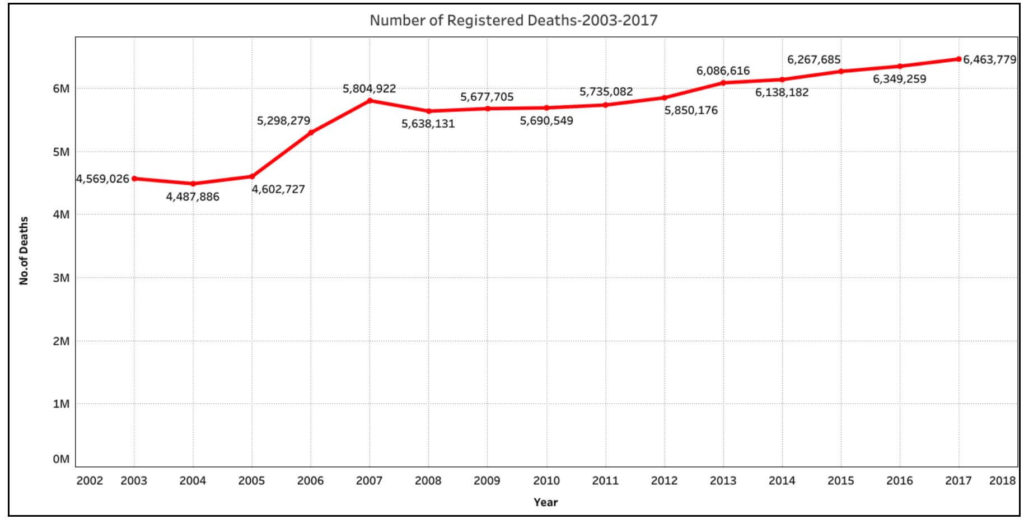
As per the ‘Vital Statistics of India’ report, there is a marked improvement in the number of deaths being recorded vis a vis the estimated number of deaths, which is a good indicator for the quantum of the deaths being recorded. It also needs to be noted that while the number of recorded deaths has increased, the estimates have fallen over the years. This could also be due to improved quality of life and general improvement in health care facilities. The estimated number of deaths in 2017 was around 80 lakh.
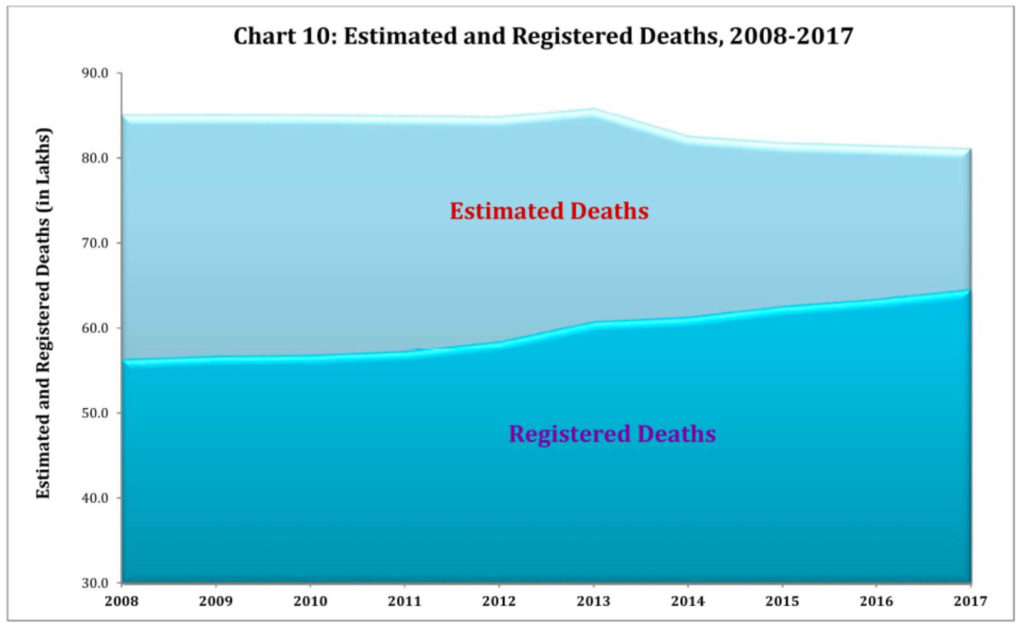
Increase also observed in the number of Medically Certified Deaths
Registering a death is the first step in ensuring the availability of vital information about deaths. Apart from this, identifying the cause of death is another important aspect of registering deaths which would also ensure that comprehensive information is available regarding deaths in the country. As highlighted earlier in the story, RBD ACT 1969, contains provisions for Medical Certification of Cause of Death.
Section 10(2) of this act empowers the State governments to enforce the provisions for medical citification of cause of death. Section 10(3) provides for issuing a certificate of cause of death by the medical practitioner who has attended the deceased at the time of death.

However, the scheme is limited to certain hospitals and medical centres. As of 2017, only 58,240 medical institutions are covered under MCCD. Therefore, the share of medically certified deaths compared to the total number of registered deaths is quite low.
In 2017, there were a total of 14.11 lakh Medically certified deaths, which is only around 22% of the total registered deaths. This is the highest recorded number of medically certified deaths (MCD) in a year till date. In fact, there has been a gradual improvement in the number of medically certified deaths since 2014.
The percentage of MCDs among the total number of registered deaths is also the highest in 2017 with 22%. The previous highest was also 22% in 2015. The percentage has substantially increased from 2003, wherein it was only 13.5%. The number of States/UTs reporting MCDs has also increased from 15 in 2003 to 35 in 2017.

Maximum share of Medically Certified deaths is in the Age group of 70 and above
Out of the 14.11 lakh medically certified deaths in 2017, 26.1 % of them i.e. around 3.68 lakh deaths were of people who are 70 years or more. The number of medically certified deaths have a progressive correlation with the age of individuals, with a higher share of deaths being recorded in the age groups of more than 45 years of age. Apart from these deaths among the older age groups, deaths among infants i.e. less than one year of age is also significant. In 2017, there were around 1.05 lakh infant deaths recorded and medically certified, which makes up for around 7.5% of the total.

Diseases of Circulatory System, the major cause among Medically Certified Deaths
Of the total medically certified deaths in 2017, 33.8% of them are due to the– ‘Diseases of Circulatory System’. Even in the previous years, the number of deaths due to diseases of Circulatory system occupy the major share among the MCDs. During the 10-year period of 2008-17, the proportion of deaths due to this cause has hovered around 30% of total MCDs.
The next highest proportion of MCDs are due to infectious and parasitic diseases. In 2017, the deaths due to these causes were 10.4% of the total. Over the years their share has been continuously decreasing.
Deaths due to ‘Diseases of Respiratory System’ are another major cause of Medically Certified deaths, with around 10% of the total MCDs over the years. The trend under this category has fluctuated over the years but has shown an increasing trend in the years prior to 2017.
A significant portion of Medically Certified deaths i.e. 13.9% are categorized under ‘Others’. During the 10-year period of 2008-2017, the share of deaths categorized as ‘Others’ has increased from 12.1% to 13.9%.
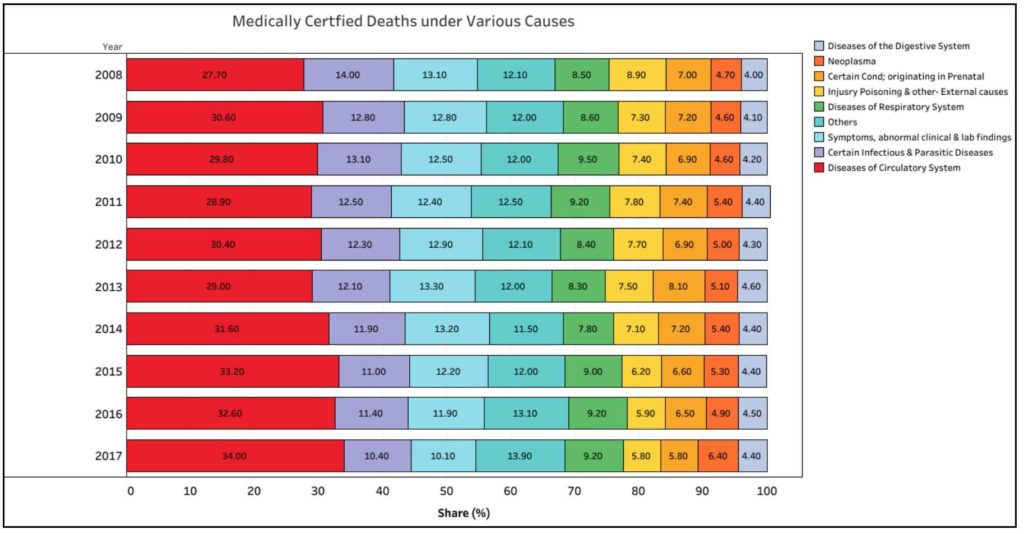
Maharashtra, Delhi, Tamil Nadu among States with highest ratio of recorded deaths, while U.P. Bihar and Uttarakhand have lowest
In 2017, 38.9% of the registered deaths in Maharashtra are certified. Although only around 20% were certified in previous year, 34.5% of the recorded deaths were medically certified in 2015.
Delhi has 60.7% of the recorded deaths as medically certified in 2017, which is higher than the previous two years with 56% and 57.2 % respectively. Tamil Nadu and Karnataka are among the other two states which have comparatively higher share of recorded deaths being medically certified.
On the other hand, Uttar Pradesh and Bihar have very low rates of recorded deaths being medically certified with 8.6% and 6.8% in 2017. The previous years also do not show any different trend. Uttarakhand is another comparatively larger state with lower ratio of medically certified deaths.
Kerala also has a smaller number of medically certified deaths out of the total registered ones.
This is a reflection of the low number of medical institutions covered under MCCD in these three states.

It is not just the proportion of medically certified deaths among the registered deaths, few states like Uttar Pradesh, have significantly lower number of deaths registered compared to the estimates.
The information provided in ‘Vital Statistics of India’ based on CRS Report -2017, highlights the level of registration of deaths. While U.P, Bihar and Uttarakhand have very low registration of deaths, few big states like Maharashtra, Andhra Pradesh, Rajasthan, Gujarat have recorded higher rate of Death registration compared to the estimates.
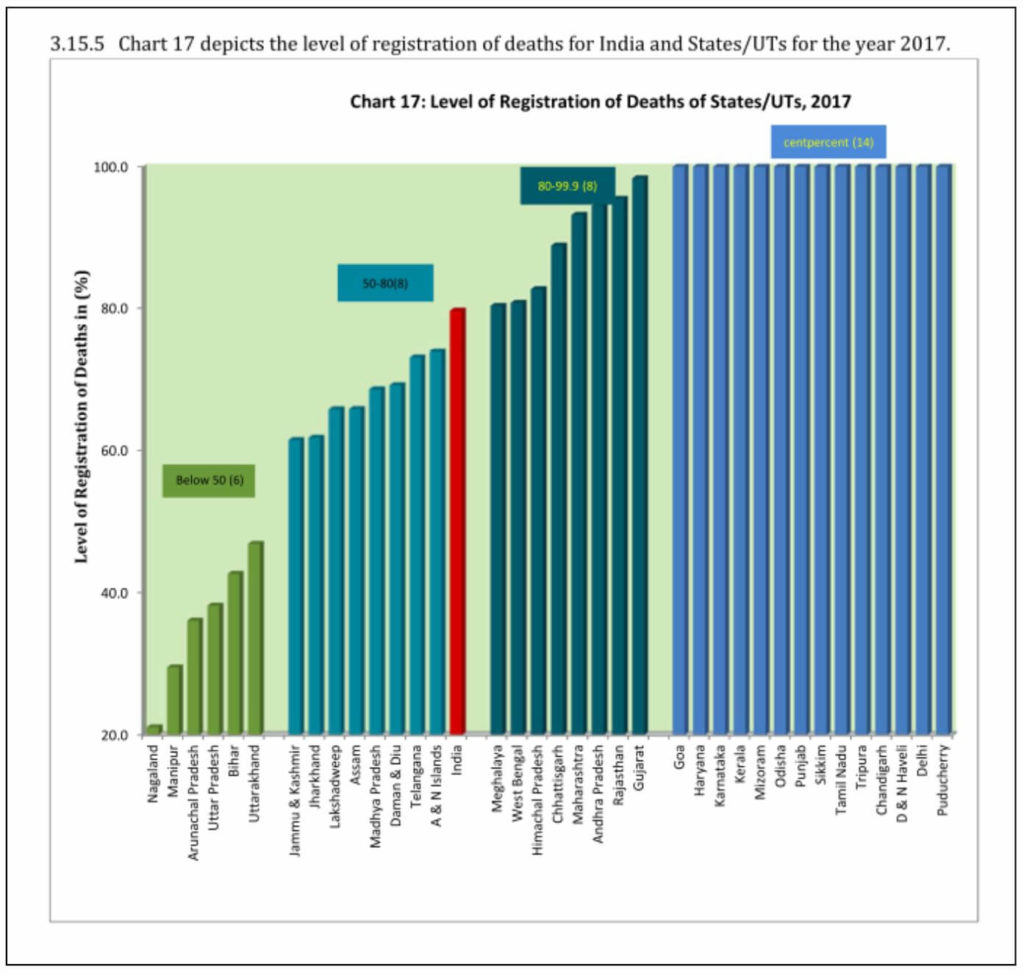
Lack of proper data hampers any meaningful analysis regarding deaths in India.
Many inconsistencies exist in recording and certifying a death in India. These inconsistencies vary according to the states, with few states doing better than the others. The challenge with respect to the death numbers is at two levels.
- Lower registration of deaths compared to the estimates
- Lower proportion of medically certified deaths compared to the registered deaths.
An infographic in the report on ‘Medical Certification of Cause of Death’ clearly depicts the very low proportion of the medically certified deaths. Although the trend shows an improvement over time, there are still a large number of registered deaths that do not have a medically certified cause.
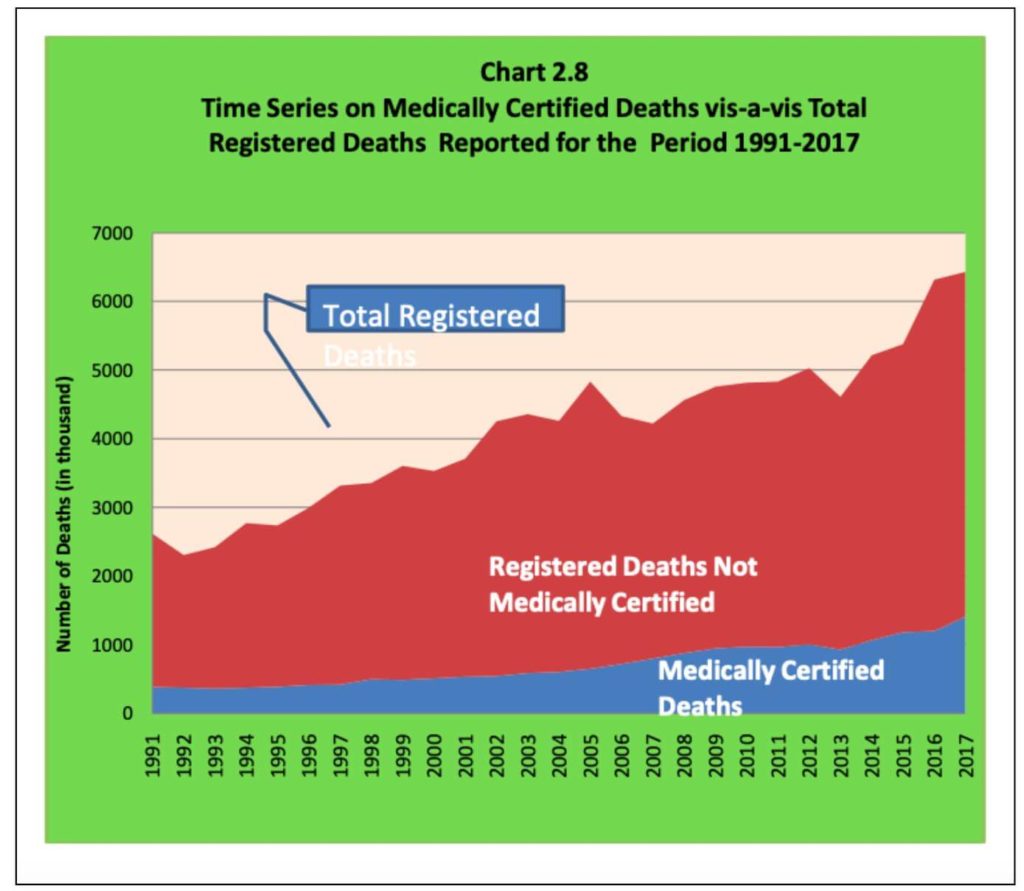
If these are compared to the estimated number of deaths, the proportion of medically certified deaths is much lower. Such low numbers of deaths with certified medical causes, do not provide help in understanding the underlying causes of death and for the governments to take any corrective action.
It is in this context that there are apprehensions about the reported number of COVID-19 deaths. It is possible that there could be a large number of cases which are not categorized as related to this infection and in many other instances, might not be registered at all. While the number of deaths due to COVID-19 is not yet alarming even compared to the normal death rate, proper data collection will go a long way in understanding the pandemic better.
Featured Image: Deaths due to COVID-19


